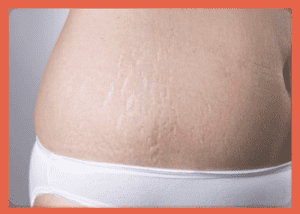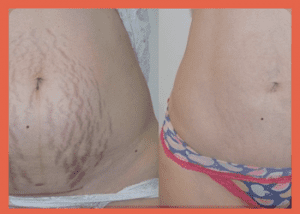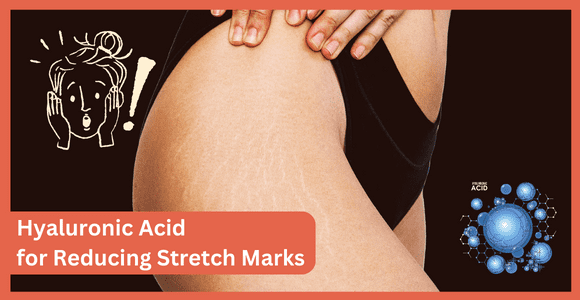Throughout the years, multiple of us develop stretch marks for a myriad of causes. Puberty, pregnancy, sudden weight gain/loss, and genetics can all play a role in unveiling these ridged scars on our skin.
Even though some individuals seek to eliminate them from their bodies permanently there are plenty who don’t mind having them around; after all, they’re incredibly common, 100% natural, and signify something special – just like any other scar.
Even if we have a positive attitude towards our bodies, including the curves and stretch marks, there’s nothing wrong with trying to reduce their appearance.
We need not be restricted by the notion of “scars” as something permanent; instead, we can investigate all possible treatments that may help us smooth them out! That being said, we decided to take matters into our own hands and do some research on this subject.
In this article, we will explore the benefits of hyaluronic acid for reducing stretch marks and discuss how it works to improve the appearance of the skin.
Table of Contents
What Exactly is a Stretch Mark?
Stretch marks, a kind of scarring that appears when your skin is stretched or contracted too quickly, occur because the collagen and elastin which maintain our skin’s integrity are ruptured. As you heal, these distinctive stripes may appear on your body.
One’s hormonal levels seem to affect their risk of developing stretch marks; moreover, if somebody in your family has them too it increases the likelihood for you as well.
 If you develop stretch marks, you’re most likely to do so during these times:
If you develop stretch marks, you’re most likely to do so during these times:
- Growth spurts that happen in puberty
- Pregnancy
- Rapid weight loss or gain
- Weight training when you have rapid muscle growth
- Prolonged application of a corticosteroid to your skin may cause stretch marks, particularly if you have Cushing’s disease or Marfan syndrome.
At first, stretch marks can be visible with a tinge of colors ranging from red to dark brown, depending on your skin tone.
They usually have an itchy feeling and slightly raised texture when they first appear. Over time these streaks will become less prominent and may sink below the surface of your skin; you might even feel a slight depression if you brush over them with your finger.
Benefits of Hyaluronic Acid for Reducing Stretch Marks
Hyaluronic acid is a naturally occurring molecule in the body that promotes skin hydration and flexibility. It’s become extremely popular amongst skincare products and cosmetic treatments because of its capacity to reduce fine lines, wrinkles, and other signs of aging.
Although research on hyaluronic acid’s effect on stretch marks is scanty, many people give accounts of it being effective at reducing their appearance over time., here are some potential benefits of using hyaluronic acid for reducing stretch marks:
| Potential Benefits |
|---|
| Hydration: HA has the ability to hold up to 1000 times its weight in water, making it an effective moisturizer for the skin. This hydration can help to improve the texture and plumpness of the skin, potentially reducing the appearance of stretch marks. |
| Collagen production: HA has been shown to stimulate collagen production in the skin, which is important for maintaining its elasticity and firmness. This can help to improve the appearance of stretch marks and prevent new ones from forming. |
| Skin regeneration: HA may help to promote the regeneration of skin cells, which can help to improve the overall appearance of the skin and potentially reduce the appearance of stretch marks. |
| Anti-inflammatory: Hyaluronic acid has anti-inflammatory properties, which can help to reduce redness and inflammation associated with stretch marks. |
Hyaluronic acid might be beneficial for reducing the look of stretch marks. However, studies are limited and results may differ from person to person.
It could be more effective when used alongside other treatments like laser therapy or microneedling. To determine the most appropriate treatment plan suited specifically for you, it is best to consult a healthcare provider or skincare specialist before proceeding with any course of action.
Is Vitamin C Serum Good for Stretch Marks?
Vitamin C is a great treatment for stretch marks and there are numerous scientific reasons why this is the case. Let’s take a look at what exactly makes up these types of scars, so we can better understand how Vitamin C supplement helps to reduce their appearance.
Your skin consists of collagen and elastin; both of which become susceptible to breaking down when put under stress or pressure from rapid expansion or contraction – this results in long, thin lines that form referred to as stretch marks. To paint an image: think about taking a balloon before you blow it up, stretching it hard with your fingers until wrinkles start showing on its surface – similar concept here!
For optimal healing, several vitamins help enhance collagen and elastin production. As proven in a 2001 study, vitamin C is notably powerful when topically applied to stretch marks on a regular basis.
To take advantage of this nutrient-packed powerhouse for your skin’s benefit, seek out oil-based products that are rich in Vitamin C – such as Marula Oil which also contains many other nutritious aspects.
How to Remove Stretch Marks Permanently?
Stretch marks, or striae, are common skin conditions that affect many people. They occur when the skin is stretched rapidly, causing damage to the underlying tissues and leaving behind a visible scar.
While stretch marks are generally harmless, they can be unsightly and may cause discomfort or self-consciousness for some individuals.
There are a variety of methods that people use to try to remove stretch marks permanently, but it’s important to note that not all of these methods are effective or supported by scientific evidence.
Here are some scientifically-supported ways to reduce the appearance of stretch marks and potentially remove them permanently:
- Tretinoin on old cream: This prescription stretch mark cream, which is a form of vitamin A, has been shown to improve the appearance of stretch marks in some studies. It works by increasing collagen production and promoting skin cell turnover. However, it may not be safe for use during pregnancy or breastfeeding.
- Laser therapy: Several types of laser treatments have been shown to improve the appearance of stretch marks. Fractional laser therapy, which creates microscopic injuries in the skin to stimulate healing and collagen production, is one example. However, laser therapy can be expensive and may not be covered by insurance.
- Microneedling: This minimally invasive procedure involves using a device with small needles to create micro-injuries in the skin. This can stimulate collagen production and improve the appearance of stretch marks. However, the results may not be permanent and multiple treatments may be necessary.
- Topical creams: There are a variety of over-the-counter creams and lotions that claim to reduce the appearance of stretch marks. While some may be effective, the evidence for their effectiveness is limited and they may not work for everyone.
It’s important to note that while these methods may reduce the appearance of stretch marks, they may not completely remove them. Additionally, some of these treatments may not be suitable for everyone, and it’s important to discuss any potential treatments with a healthcare provider.
Before and After Results
It is a common belief that hyaluronic acid may help reduce the appearance of stretch marks. Hyaluronic acid is a naturally occurring substance in the body that helps to keep the skin hydrated and plump. When applied topically or injected into the skin, hyaluronic acid can help to fill in and smooth out the skin, potentially reducing the appearance of stretch marks.
Before starting any treatment, it’s important to consult with a healthcare provider to determine if hyaluronic acid is safe and appropriate for your individual needs. They can also help to manage your expectations and provide realistic before and after results.
 In some cases, hyaluronic acid may be injected into the skin using a fine needle. The injection site may be numbed with a local anesthetic to minimize discomfort.
In some cases, hyaluronic acid may be injected into the skin using a fine needle. The injection site may be numbed with a local anesthetic to minimize discomfort.
After the injection, patients may experience some mild swelling and redness, but this typically resolves within a few days.
The results of hyaluronic acid injections for stretch marks can vary. Some patients may see a noticeable improvement in the appearance of their stretch marks, while others may not see much of a change.
The results may also be temporary, lasting only a few months before the treatment needs to be repeated.
In addition to injections, hyaluronic acid can also be used topically in the form of creams and serums. These products can help to hydrate the skin and improve its texture, potentially reducing the appearance of stretch marks over time. However, the results of topical treatments may be less dramatic than those of injections, and it may take longer to see results.
In conclusion, hyaluronic acid may be a potential option for reducing the appearance of stretch marks, but it’s important to discuss this treatment with a healthcare provider and manage your expectations for before and after results. While some patients may see significant improvements, others may not experience much of a change. Additionally, the results may be temporary and require ongoing treatment to maintain.
Frequently Asked Questions
What Acids are Best for Stretch Marks?
Glycolic acid peels have been proven to effectively treat white stretch marks (striae alba), as they prod the skin into producing more collagen.
What Removes Stretch Marks Completely?
Stretch marks can be a disheartening reminder of pregnancy, fluctuations in weight, or bodybuilding. Fortunately, there are several treatments available to diminish the appearance of stretch marks: laser skin resurfacing, dermabrasion, microneedling, and retinol creams. With one or more of these options, you can regain confidence in your own skin.
Can You Use Hyaluronic Acid on Pregnant Belly?
Although using hyaluronic acid while pregnant should be safe, it’s always wise to check with your healthcare provider first for the best assurance of safety. With its tremendous anti-aging and healing properties, there is a valid motive why you can consider utilizing this ingredient throughout pregnancy. Hyaluronic acid has been known to provide deep hydration that is necessary during this special time in life.
What is the Fastest Way to Get Rid of Stretch Marks?
- Laser therapy
- Microdermabrasion
- Microneedling
- Radiofrequency therapy
- Chemical peel
Can I Use the Ordinary Hyaluronic Acid for Stretch Marks?
Using ordinary hyaluronic acid may provide some hydration benefits for stretch marks, but it is not a treatment specifically designed for addressing them.
What is the Most Effective Treatment for Stretch Marks?
The most effective treatment for stretch marks, scientifically referred to as striae, is a matter that has long been the focus of research and medical inquiry. Stretch marks are characterized by the linear, discolored bands that appear on the skin when it undergoes rapid stretching, often due to factors such as pregnancy, rapid weight gain, or growth spurts during adolescence. While it can be challenging to completely eliminate stretch marks, various treatments have shown varying degrees of effectiveness in reducing their appearance.
One of the most widely recognized treatments for stretch marks is topical application of creams or ointments containing ingredients like retinoids (topical vitamin A derivatives), hyaluronic acid, or peptides. These compounds aim to improve collagen production and skin elasticity, which can help diminish the appearance of stretch marks over time. However, it’s crucial to understand that results from these topical treatments can be modest, and they are most effective on relatively new, red or purple-colored stretch marks.
Another approach to managing stretch marks involves laser therapy. Fractional laser treatments, such as fractional laser resurfacing, have shown promise in stimulating collagen production and improving the appearance of stretch marks. These procedures work by creating controlled micro-injuries in the skin, prompting the body’s natural healing processes to enhance the texture and color of the affected areas. Laser treatments can be particularly effective for mature, white or silver stretch marks.
Chemical peels, microdermabrasion, and microneedling are additional cosmetic procedures that can aid in reducing the appearance of stretch marks. Chemical peels involve the application of a chemical solution to exfoliate the skin’s top layer, while microdermabrasion employs abrasive techniques to remove the outer skin layer. Microneedling utilizes a device with fine needles to stimulate collagen production and improve skin texture.
For more severe cases, particularly when stretch marks are profound and treatment-resistant, dermatologists may recommend other advanced procedures, such as platelet-rich plasma (PRP) therapy or fractional radiofrequency. PRP therapy involves injecting platelet-rich plasma from the patient’s own blood to stimulate skin rejuvenation, while fractional radiofrequency utilizes radiofrequency energy to target and remodel the skin’s deeper layers.
Ultimately, the effectiveness of any treatment for stretch marks can vary from person to person, depending on factors like the age and color of the stretch marks, skin type, and the treatment’s timing. It is essential to consult a dermatologist or healthcare professional to assess the most suitable treatment option and to manage expectations regarding the reduction of stretch marks. In many cases, a combination of treatments may yield the best results. Additionally, maintaining good skin hydration and overall skin health can contribute to preventing the formation of new stretch marks.
Conclusion
It’s time, to be honest with ourselves. It is important for us to comprehend the real meaning of “improving stretch marks’ appearance” when it is uttered by experts or advertisers. Generally, this improvement can be assessed by comparing the size and pigmentation disparities between scars and your skin color.
Noteworthy improvements include less discoloration and slower growth of your stretch marks. While we can’t guarantee that they’ll vanish entirely, scars like these are a testament to our body’s unique journeys – something truly special!
Your stretch marks are a representation of an intimate time in your life, so if you would like to remove them from any part of your body – such as the buttocks or breasts – remember it is essential to have realistic expectations.
We think that stretch marks should be something we embrace and not hide away; therefore at this company, we strive for our customers’ body confidence! While everyone has different comfort levels with their own skin, loving your stretch marks might just give you an extra boost of self-confidence.
